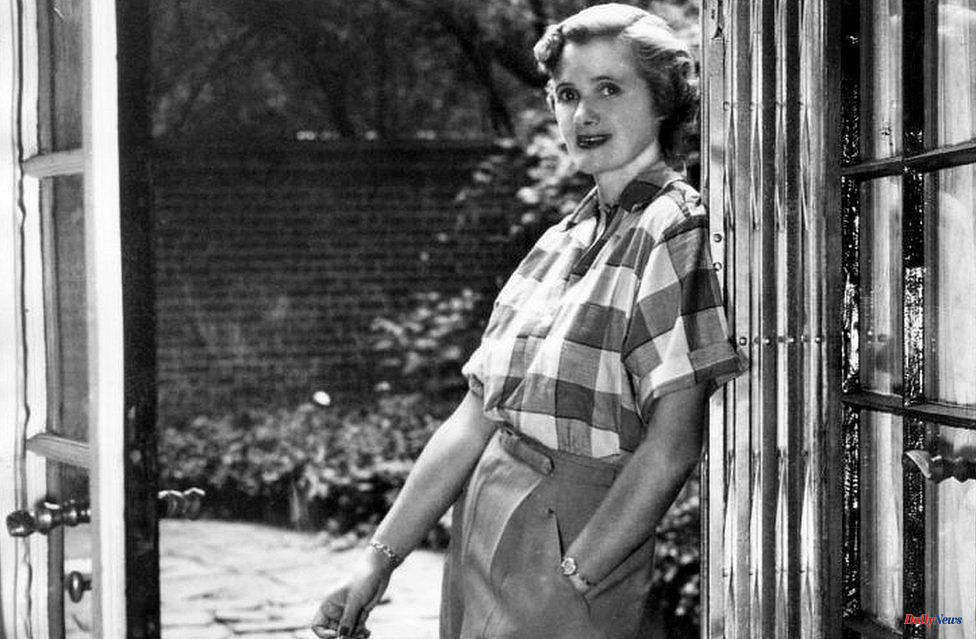Dame Daphne du Maurier was an English novelist who died at the age of 89. She was fascinated by her French heritage.
Jamaica Inn and Rebecca were inspired by stories of an aristocratic ancestor, who fled the guillotine as well as the militant sans-culottes to reach London during the French Revolution.
However, when she started to look into her family history she found it was much more complicated. Her French ancestors weren't nobles. They were bourgeois artisans who trade in glassmaking.
The 1790 emigre wasn't a runaway from revolutionary mob but was a prisoner of debt.
It is possible to trace the steps of Daphne du Maurier's research in France during the 1950s. She drove around the Perche region 120 miles (190km), south-west from Paris and visited the farmsteads of chateaux, glass foundries, and farmsteads that were featured in her family history.
They became the setting for her 1963 historical novel The Glass-Blowers, in which she told of her great-great-grandfather Robert Busson, of his modest roots making perfume bottles in the forests near Le Mans, and how he came to sire an artistic dynasty of English du Mauriers in London.
Her first stop was Le Gue de Launay, the house that was once home to her ancestor, Sophie Duval.
The basis for all future investigations was Sophie's 1840s-written letters that are now kept at Exeter University. They were a reflection of Sophie's long and illustrious life. She was the daughter, sister, and then wife of glass-blowers in 1760s.
Daphne du Maurier created the opening scene for her novel The Glass-Blowers from the terrace of the house. It is still there, hidden among the wooded vales, pastures, and remains.
Mary Buisson, the current Anglo French owner, says that Daphne du Maurier arrived here to find a place for her book's opening. She is a huge fan of the author.
"She used to read our books under the sheets in our convent. I never would have guessed that I would find myself in the home of my ancestor.
This area of France is still heavily forested. It was even more forested in the 18th century. It was probably due to this, and possibly the arrival of Italian artisans at an unrecorded time in medieval times, that it became one of the main centers of pre-industrial era glasses manufacturing.
"To make glass you need wood, clay, and sand. They had all of them here," Bernard Malcor, an expert on the old glass foundries and verreries, says. Since 1803 his family has been living in Le Plessis-Dorin.
MORE FROM HUGH: Rumer Godden's French past
One of the foundries Daphne's ancestors operated in Le Plessis was Dorin. It was here that Robert Busson, an ancestor of du Maurier, started a commercial enterprise that eventually failed, forcing him to move post-haste to the channel ports.
The original foundry was renamed and continued to operate until the 1950s. It employed hundreds of workers and supplied phials for perfume-makers such as Guerlain and Coty. Hard economics prevailed, just like all the other verreries. They were unable to compete with the new big factories and closed.
The woods and the fields still have their memories. There are many place names that include the word verrerie today. Locals still find lumps of what appears to be vitreous rock, which is molten dregs left over from the furnaces. These were then smashed and used to line the muddy lanes.
"Over the centuries there would have been hundreds glass foundries in the forests. They would consume wood from a particular area and then move on. It was a little like slashing and burning in the Amazon," Frederic de Montalembert says. Frederic de Montalembert's Chateau de La Pierre also has a du Maurier connection.
Mathurin Busson was Robert's father and managed La Pierre's verrerie when he was a child. The chateau was allowed to house the family of upper-class artisans during this period.
Robert Busson was able to have delusions of grandeur because of this. We know that after leaving for London, he assumed the name du Maurier. It was incorrectly understood that he was entitled.
Robert Busson du Maurier was the one who sparked the line that led to Daphne.
Other du Mauriers of artistic renown were also present. Robert's son was an inventor. His grandfather, Daphne, was the novelist/punch cartoonist George du Maurier.
George was just as well-known as Daphne in his day. His cartoons were a social commentary that helped to create British humor. Additionally, his novel Trilby, which indirectly gave the name to the hat, was one of the first blockbusters.
Gerald du Maurier, an actor-manager, was Daphne’s father.
Are all the generations of du Mauriers still influenced by their supposed aristocratic pasts? Or did they suspect that it was a fake?
There is no clear answer. It is clear that Gerald sold Daphne the "noblesse", so when Daphne debunked it in 1950, it was a surprise to her that she discovered the family's ordinary roots.
DU MAURIER - Mistress of suspense
Anne Hall, an American academic who lives in Perche and made a study on the French connection to the du Mauriers, said that "She wasn't at all snobbish." "So, she was really proud to learn that her ancestors were craftmen."
Anne Hall believes there was a little family myth-making. She discovered that George du Maurier was born in Paris 1834 and spent holidays with Sophie Duval, his great-aunt of letter-writing, at Le Gue de Launay.
He would have been able to see more of her glass-blowing history because she was his living link.
As for Daphne du Maurier and the curious visitor of today, the destination is one hour south of Le Plessis-Dorin's verreries, La Pierre, at Cherigny, an abandoned glass foundry.
Mathurin Busson, the patriarch, was here in the 1760s starting his family.
Their home was a small farmhouse called Le Maurier. In 1747, Robert Busson was born there. His "title" was not taken from a chateau but from the cottage that he first saw daylight of day.
You can still find the farmhouse, one of many French farmhouses that you will see marked off the main road. Then drive down a mile on rutted tracks to reach it.
For the past 80 years, the Leons family has been farming the land. Yes, the Leons do receive the occasional du Maurier tourist visit.
They recall that Daphne was there, and the house has a reminder of her.
It's a French paperback edition of The Glass-Blowers with a personal dedication.
Respect and Best wishes to my ancestors, 23 September 1973. Daphne du Maurier.












